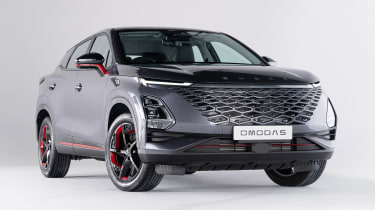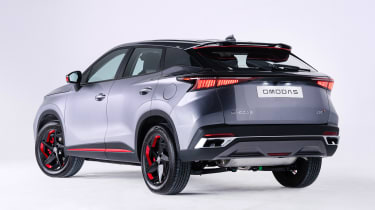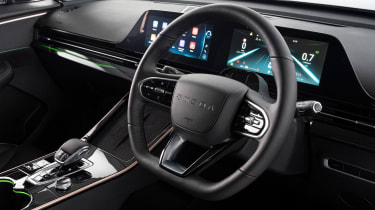The new Omoda 5 SUV will only be available with an all-electric powertrain when it hits the UK next spring, but a hybrid option is expected later
Omoda is benchmarking premium brands in a bid to match mainstream rivals with its first UK offering, the Omoda 5 SUV, which will land in dealers here next spring. And based on an early preview of the 5 in a London studio, the Chinese maker is on track to pose a serious threat to well established models such as the Nissan Qashqai and Hyundai Tucson.
This is a family-sized SUV – a little shorter than the Qashqai, but longer than the B-segment Hyundai Kona, a vehicle cited by Omoda’s engineering chief Peter Matkin as a key rival. The 5 will be offered as an EV at launch, with a 61kWh battery and a range of 280 miles, plus a hybrid is expected later.
But the core model at launch will feature a 1.6-litre turbo petrol engine, front-wheel drive and a seven-speed dual-clutch gearbox. It produces 187bhp and 275Nm, and while Omoda is still awaiting final verification, it should return somewhere approaching 40mpg on the combined WLTP test. The car already has a five-star Euro NCAP rating, earned in testing last year.
From the outside, the Noble trim level that we were presented with in the studio has a complex front grille (the EV’s will be cleaner and more flush to reflect its powertrain), and red styling flashes in areas such as the side-mirror supports and some parts of the 18-inch alloy wheels. The overall profile is quite rakish by SUV standards, with a blacked-out C-pillar helping to deliver a ‘floating roof’ effect.
Inside, it’s easier to see how Matkin’s team have aimed high by benchmarking Audi and Mercedes, in the hope of getting close enough to those premium brands’ level of execution – and to embarrass the 5’s real rivals. The finish is smart, and build quality feels up there with some of the strongest offerings in the family SUV class.
There are hard plastics on some areas of the doors and dash, including a hefty chunk of piano-black trim on the centre console. But in general, the parts you’re likely to touch have dense, padded material – and although some of the switches are recognisable off-the-peg items from established suppliers, they seem solid enough. Even the simple rotary volume control is nicely weighted and damped.
As with many of the new Chinese offerings, the level of in-car tech is unlikely to disappoint. There’s an Android-based infotainment system that also boasts Apple CarPlay, along with a voice assistant that can perform vehicle functions such as opening and closing the boot and sunroof. The eight-speaker sound system is sourced from Sony, and typical Chinese extras include adjustable ambient lighting that can reflect the car’s various driving modes.
The dashboard’s pair of 10.25-inch displays – one for the infotainment, the other for the driver instruments – look crisp, and the system seems to respond snappily to inputs. A lot of functionality is incorporated into a tablet-style interface, but it appears simpler to use than the set-ups in some rivals. Omoda has wisely still included physical buttons for the heating and ventilation controls.
There is a fair amount of legroom for six-footers in the rear, and they’re unlikely to complain about headroom, even with the slightly sloping roofline and a sunroof. The boot, meanwhile, measures a respectable 380 litres in capacity – the same as in a Volkswagen Golf – and a minimal load
lip means it should be easy to slide heavy items in. There is a notable absence of any bag hooks on the sides of the boot, though.
The 5’s trump card could well be its pricing. It has an entry point of £24,000, which is around £2,500 less than the cheapest Qashqai. But there’s no word yet on what finance arrangements will be in place – a key factor for private customers.
Omoda also faces a race to get a suitable dealer network in place, with the firm’s UK branding manager Matthew Upton telling us that the goal is for 50 outlets by March, when the 5 should go on sale. The compact SUV will be followed in UK showrooms next year by the Jaecoo 7, a larger, more premium model that will offer a choice of regular petrol or plug-in-hybrid power.
Q&A with Peter Matkin
Omoda’s engineering team leader
Peter Matkin, Omoda engineering team leader, spent more than 15 years at Jaguar Land Rover working on cars such as the S-Type, before moving to China in 2010. Here’s his view on how the brand is adapting for Europe.
Q: A big part of Omoda’s fortunes may depend on how quickly it adapts to European tastes. How is that going?
A: It’s not always easy, but I think we have a good line of communication. I’ve been here quite a while now, and I’m the link between our engineers in Germany and the team in Shanghai. We bring vehicles over so the Chinese team can get better context of what we’re discussing or requesting – down to things such as towing, which doesn’t happen here.
Q: What cars are you benchmarking the 5 against?
A: That part of the process works a bit differently in China. In Europe, we’d pick a competitor set fundamentally based on the price bracket of the car; over there, we look at the more luxury end of the spectrum – Mercedes, BMW, Audi, Lexus. It’s not because we achieve the same level, but we’ll get further than if we were to just benchmark cars in the same price bracket. You can get better products and componentry in China, because the business model is different; we get praised on the quality of our materials.
Q: But from an engineering perspective, you must have a particular vehicle in mind?
A: Yes, we do. We see our direct competitor as the Hyundai Kona. We’ve been looking at a lot of the attributes for that model. We’ve tested the Omoda 5 in Germany, Italy and Spain; we haven’t done any specific driving in the UK, but we’re accelerating the launch there. I’m confident the work we’ve done in Europe and in China should carry over; I see no reason why it shouldn’t. We’ve got stiffer anti-roll bars, changed the sub-frame bush, spring rates, steering tuning, damper rates – a lot of work on the vehicle dynamics to make sure it matches European and UK consumers’ tastes.
Click here for our list of the best electric SUVs on sale right now…
Source: Read Full Article






